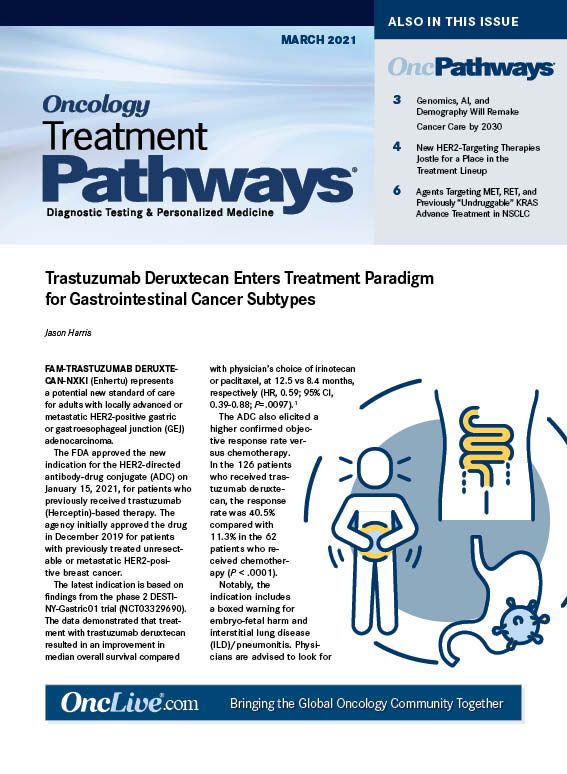New HER2-Targeting Therapies Jostle for a Place in the Treatment Lineup
The introduction of new therapies for patients with recurrent HER2-positive metastatic breast cancer has resulted in a crowded landscape for third-line treatments and beyond, raising questions about how best to sequence a wealth of options.
Sara A. Hurvitz, MD

The introduction of new therapies for patients with recurrent HER2-positive metastatic breast cancer (mBC) has resulted in a crowded landscape for third-line treatments and beyond, raising questions about how best to sequence a wealth of options, according to Sara A. Hurvitz, MD.
There are now 8 HER2-targeting agents available for patients with mBC, Hurvitz said; these include 3 new drugs that the FDA approved in the past 15 months.1 Meanwhile, additional regimens are in development that may further change the paradigm.
“This continues to be an incredibly exciting time for the treatment of HER2-positive breast cancer given all these new agents but we are challenged to understand how to best sequence these agents, which really will require us to take into account the unique safety profile and efficacy profile of each of these agents,” Hurvitz said during a presentation at the 38th Annual Miami Breast Cancer Conference®.Hurvitz is director of the Breast Cancer Clinical Research Program UCLA and codirector of the Santa Monica–UCLA Outpatient Hematology/Oncology Practice.
As it stands now, she said, the gold standard for first-line HER2-positive mBC is the combination of trastuzumab (Herceptin), pertuzumab (Perjeta), and a taxane. For second-line therapy, she said the first choice is ado-trastuzumab emtansine (T-DM1; Kadcyla), although the tucatinib (Tukysa) triplet approved in April 2020 may become another option in this setting. In that regimen, tucatinib is combined with trastuzumab and capecitabine.
In the third-line setting, there are at least 8 choices, including 3 new drugs and an expanded indication for a fourth agent, which have been approved since December 2019.1 Besides the tucatinib regimen, the recent additions to the treatment toolkit comprise the new drugs fam-trastuzumab deruxtecan-nxki (Enhertu) monotherapy and margetuximab-cmkb (Margenza) plus chemotherapy, as well as an expanded indication for neratinib (Nerlynx) combined with capecitabine.
Wave of Recent Approvals
During her presentation, Hurvitz reviewed data for the 4 recently approved therapies in detail and described efforts to advance their use in ongoing clinical studies.
Trastuzumab deruxtecan, an antibody-drug conjugate, gained an accelerated approval in December 2019 for patients with unresectable or metastatic HER2-positive breast cancer who have received 2 or more prior anti-HER2-based regimens in the metastatic setting.
The decision was based on findings from the phase 2 DESTINY-Breast01 trial (NCT03248492), a multicenter, single-arm in which 184 patients received trastuzumab deruxtecan. Hurvitz pointed out that 92% of participants had visceral disease and the population had undergone a median of 6 prior lines of therapy, including 1 patient who had received 27 lines of treatment in the metastatic setting.
“We were blown away to see the objective response rates [ORRs],” Hurvitz said. Updated data presented at the 2020 San Antonio Breast Cancer Symposium (SABCS) showed an ORR of 61.4%, with a median duration of response of 20.8 months, median progression-free survival (PFS) of 19.4 months, and a median overall (OS) of 24.6 months.2 Hurvitz noted that patients receiving the drug should be monitored for interstitial lung disease, which was fatal in 2.7% of patients.
The drug is being evaluated in a number of phase 3 trials, including DESTINY-Breast02 (NCT03523585), the confirmatory study for the approval, which is comparing trastuzumab deruxtecan versus investigator’s choice of capecitabine plus either trastuzumab or lapatinib (Tykerb) in patients with mBC who previously received T-DM1.
The phase 3 DESTINY-Breast03 trial (NCT03529110) is testing whether trastuzumab deruxtecan can bump T-DM1 as the preferred choice in the second-line setting; the study directly compares the 2 drugs in a randomized population. This study is recruiting patients with mBC who previously received trastuzumab plus a taxane.
In February 2020, neratinib received an expanded indication in combination with capecitabine for patients with advanced or metastatic HER2-positive breast cancer who have received 2 or more prior HER2-directed regimens in the metastatic setting. The approval for the tyrosine kinase inhibitor (TKI) was based on the phase 3 NALA trial (NCT01808573), in which patients were randomized to receive capecitabine with either neratinib or lapatinib.
Notably, the dose of capecitabine was lower in neratinib arm (1500 mg/m2) than it was in the lapatinib cohort (2000 mg/m2) because of concerns about diarrhea. Patients treated with neratinib also received loperamide starting with the first dose to mitigate diarrhea. Nevertheless, about 24% of patients developed diarrhea of grade 3 or 4 severity with neratinib versus 13% with lapatinib.3 “This is a big limiting factor for the use of this agent,” Hurvitz said.
In findings from an updated analysis, PFS was 8.8 months in the neratinib arm versus 6.6 months with lapatinib (P = .003). Neratinib also improved outcomes for patients with stable central nervous system (CNS) disease at baseline, according to data from the NALA trial presented at SABCS 2020. The mean PFS was 7.8 months in the neratinib arm versus 5.5 months in the lapatinib arm (HR, 0.66; 95% CI, 0.41-1.05; P = .074).4
Efficacy against CNS disease also is one of the striking features of tucatinib therapy, a TKI that gained FDA approval in May 2020 in combination with trastuzumab and capecitabine for patients with HER2-positive mBC, including patients with brain metastases, who have received 1 or more prior anti-HER2–based regimens in the metastatic setting.
Hurvitz said the pivotal phase 2 HER2CLIMB trial (NCT02614794), in which patients were randomized to receive capecitabine/trastuzumab in combination with either tucatinib or placebo, “was designed to interrogate” tucatinib’s efficacy against brain metastases. In all, 48% of the study’s 612 participants had CNS metastases that were stable or actively progressing.
“This drug hit a homerun at its first reporting,” Hurvitz said. The median PFS in patients receiving tucatinib was 7.8 months (95% CI, 7.5-9.6) compared with 5.6 months (95% CI, 4.2-7.1) for patients who had placebo (HR, 0.54; 95% CI, 0.42-0.71; P < .001). The median OS was 21.9 months (95% CI, 18.3-31.0)in the tucatinib arm compared with 17.4 months (95% CI, 13.6-19.9) in the control arm (HR, 0.66; 95% CI, 0.50-0.87; P = .005).Among the patients with brain metastases, PFS at 1 year was 24.9% in the tucatinib arm and 0% in the placebo group (HR, 0.48; 95% CI, 0.34-0.69; P < .001).5
In terms of adverse events (AEs), Hurvitz noted an increased risk of hand-foot syndrome and diarrhea, although the incidence of grade 3/4 diarrhea was only 12.9% versus 8.6% in the placebo arm,5 which she said compares favorably with the neratinib data. Tucatinib’s HER2 selectivity “reduces the risk of diarrhea and you don’t need to use upfront loperamide with this agent,” she said.
Although the pivotal tucatinib study was a third-line trial, the FDA approved the regimen in the second line, probably because of its “incredible activity” in patients with brain metastases, Hurvitz said. The question now is whether tucatinib can advance past T-DM1 monotherapy in the second-line setting. In the phase 3 HER2CLIMB-02 trial (NCT03975647), the combination of tucatinib plus T-DM1 is being compared with placebo plus T-DM1.
Margetuximab, which was approved in December 2020 in combination with chemotherapy for patients with HER2-positive breast cancer who have received 2 or more prior anti-HER2 regimens, “is a uniquely designed trastuzumab,” Hurvitz said.
“It has the same Fab portion that targets HER2 but the Fc portion is engineered to more tightly bind to the patient’s immune effector cells, NK [natural killer] cells and dendritic cells at the Fc receptor,” she said. “We know that about 85% of patients will have an Fc receptor genotype that indicates weaker binding affinity for antibodies. Engineering this to more tightly bind may benefit patients.”
The chimeric monoclonal antibody was approved based on findings from the phase 3 SOPHIA trial (NCT02492711), which demonstrated a PFS benefit for margetuximab plus chemotherapy over trastuzumab plus chemotherapy. Median PFS in the margetuximab arm was 5.8 months (95% CI, 5.52-6.97) compared with 4.9 months (95% CI, 4.17-5.59) in the control arm (HR, 0.76; 95% CI, 0.59-0.98; P = .033).6
Hurvitz said the PFS benefit appears to be restricted to participants who were carriers of the CD16A receptor with a 158F allele. Additionally, she noted, there was a median 4.3-month difference in OS in the margetuximab arm compared with the control arm (23.7 vs 19.4 months, respectively) in patients who were CD16A-158F carriers, although it was not statistically significant (P = .087 by unstratified log rank). These patients comprised 437 of trial participants, or 86% of those who were genotyped (506 patients of 536).
In terms of AEs, Hurvitz said margetuximab has a favorable profile. “The tolerability of this agent is really quite good,” she said. “The only thing that is increased compared with trastuzumab is infusion-related reactions. It is a good, tolerable agent we can now combine.”
Moving forward, Hurvitz anticipates that margetuximab will be used more frequently in patients who are F allele carriers. She said an assay is being developed to identify these patients.
References
- Hematology/oncology (cancer) approvals & safety notifications. FDA. Updated March 4, 2021. Accessed March 6, 2021. https://bit.ly/30fJ3ax
- Modi S, Saura C, Yamashita T, et al. Updated results from DESTINY-breast01, a phase 2 trial of trastuzumab deruxtecan (T-DXd ) in HER2 positive metastatic breast cancer. Presented at: 2020 San Antonio Breast Cancer Symposium; December 8-11, 2020; Virtual. Abstract PD3-06. Accessed March 6, 2021. https://www.abstractsonline.com/pp8/#!/9223/presentation/797
- Saura C, Oliveira M, Feng YH, et al; NALA Investigators. Neratinib plus capecitabine versus lapatinib plus capecitabine in her2-positive metastatic breast cancer previously treated with ≥ 2 HER2-directed regimens: phase III NALA Trial. J Clin Oncol. 2020;38(27):3138-3149. doi:10.1200/JCO.20.00147
- Saura C. Impact of neratinib on outcomes in HER2-positive metastatic breast cancer patients with central nervous system disease at baseline: findings from the phase 3 NALA trial. Presented at: 2020 San Antonio Breast Cancer Symposium; December 8-11, 2020; Virtual. Abstract PD13-09. Accessed March 6, 2021. https://www.abstractsonline.com/pp8/#!/9223/presentation/760
- Murthy RK, Loi S, Okines S, et al Tucatinib, trastuzumab, and capecitabine for HER2-positive metastatic breast cancer. N Engl J Med. 2020;382(7):597-603. doi:10.1056/NEJMoa1914609
- Rugo HS, Im SA, Cardoso F, et al; SOPHIA Study Group. Efficacy of margetuximab vs trastuzumab in patients with pretreated ERBB2-positive advanced breast cancer: a phase 3 randomized clinical trial. JAMA Oncol. Published online January 22, 2021. doi:10.1001/jamaoncol.2020.7932




